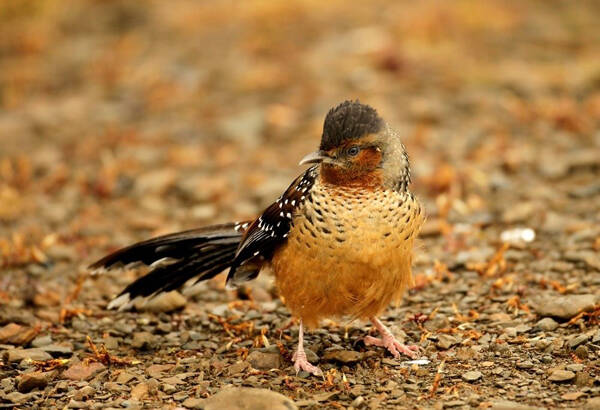Ianthocincla maxima
IUCN
LCBasic Information
Scientific classification
- name:Ianthocincla maxima
- Scientific Name:Ianthocincla maxima,Giant Laughingthrush,Garrulax maximus,Flower-backed Laughing Babbler
- Outline:Songbird
- Family:Passeriformes Thrushidae Laughingthrush
Vital signs
- length:30-37cm
- Weight:100-220g
- lifetime:About 12 years
Feature
The forehead to the top of the head is dark brown, and the back is chestnut brown with white spots
Distribution and Habitat
Native distribution: China, India.
In China, it is distributed in southwestern and southern Gansu, Yushu, Nangqian, and southeastern Banma in southern Qinghai, Mianyang, Songpan, Ruoergai, Aba in northern Sichuan, Derge, Ganzi, Luhuo in the northwest, Kangding, Litang, Yajiang, Batang in the west, Muli, Daocheng, Liangshan in the southwest, Chengdu, Leshan, Ya'an, Baoxing in the middle, Deqin, Lijiang, Zhongdian, Nujiang and Lancangjiang mountains in northwestern Yunnan, Jiangda, Leiwuqi, Chaya in northeastern Tibet, southeastern Qamdo, Zuogong, Mangkang, etc.
It mainly inhabits subalpine and alpine forest shrubs and forest margins at an altitude of 2700-4200 meters.
Appearance
The male and female Great Laughing Thrush have similar plumage. The forehead to the top of the head is dark brown or blackish brown, the front of the eyes is almost white, the back of the cheek, the ear coverts and the sides of the neck are chestnut, and the puffs are gray. The rest of the upper body is dark chestnut or chestnut brown, and each feather has a nearly circular white spot at the tip. There is black in front of or around the white spot, making the white spot particularly eye-catching; the inner coverts of both wings are the same color as the back, and the primary coverts and the large coverts are black with white end spots. The inner vanes of the primary flight feathers are black-brown, and the outer vanes of the outer vanes are dark gray at the base except for the two outermost ones, which are black-brown. The gray part gradually expands from the outside to the inside, gradually occupying most of the entire outer vane. The innermost flight feathers are the same color as th
Details
Giant Laughingthrush, foreign name, no subspecies.

The Great Laughingthrush is smaller than the similar species, the Eye-striped Laughingthrush, and has a shorter tail. It has a black throat and neck, and black and white horizontal stripes on its chest. The difference is obvious and it is not difficult to identify in the wild.
The Great Laughing Thrush often moves in groups, and often mixes with other Laughing Thrushes. It is timid and secretive, often jumping around in the dense bushes under the forest or at the edge of the forest, or foraging in the fallen leaves on the ground. It is often only heard but not seen, and its call is loud and rough. It mainly feeds on animal food such as insects and insect larvae, and also eats plant fruits and seeds. The insects it eats mainly include beetles, weevils, beetles, golden flower beetles, longhorn beetles, walking beetles, stag beetles, ladybugs, stink bugs, locusts, earwigs, grasshoppers, caterpillars, moths, crickets, ants, Lepidoptera larvae and other insects. In addition, it also eats other invertebrates such as spiders, centipedes, skinks, shrimps, snails, and invertebrates such as plant fruits and seeds.
The breeding method of the Great Laughing Thrush has not been studied yet.
Listed in the 2012 Red List of Endangered Species of the World Conservation Union (IUCN) ver 3.1 - Least Concern (LC).
Listed in the "List of Terrestrial Wildlife with Important Economic and Scientific Research Value under State Protection" issued by the State Forestry Administration of China on August 1, 2000.
Listed in the second level of China's "National Key Protected Wildlife List"
Protect wild animals and eliminate game.
Maintaining ecological balance is everyone's responsibility!








